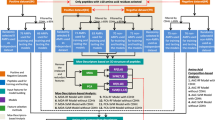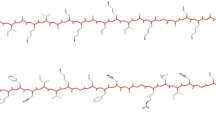Abstract
The treatment of infections caused by multi-drugs resistant bacteria and fungi is a particular challenge. Whereas cationic antimicrobial peptides (CAPs) are considered as promising drug candidates for treatment of such superbugs, recent studies have focused on design of those peptides with increased bioavailability and stability against proteases. In between, applications of the quantitative structure–activity relationship (QSAR) studies which provide information on activities of CAPs based on descriptors for each individual amino acid are inevitable. However, the satisfactory results derived from a QSAR model depend highly on the choice of amino acid descriptors and the mathematical strategy used to relate the descriptors to the CAPs’ activity. In this study, the quantitative sequence–activity modeling (QSAM) of 60 CAPs derived from O-W-F-I-F-H(1-Bzl)-NH2 sequence which showed excellent activities against a broad range of hazardous microorganisms: e.g., MRSA, MRSE, E. coli and C. albicans, is discussed. The peptides contained natural and non-natural amino acids (AAs) of the both isomers d and l. In this study, a segmented principal component strategy was performed on the structural descriptors of AAs to extract AA’s indices. Our results showed that constructed models covered more than 82, 94, 80 and 78 % of the cross-validated variance of C. albicans, MRSA, MRSE and E. coli data sets, respectively. The results were also used to determine the important and significant AAs which are important in CAPs activities. According to the best of our knowledge, it is the first successful attempt in the QSAM studies of peptides containing both natural and non-natural AAs of the both l and d isomers.



Similar content being viewed by others
References
Bagheri M, Keller S, Dathe M (2011) Interaction of W-substituted analogs of cyclo-RRRWFW with bacterial lipopolysaccharides: the role of the aromatic cluster in antimicrobial activity. Antimicrob Agents Chemother 55:788–797. doi:10.1128/AAC.01098-10
Dathe M, Wieprecht T (1999) Structural features of helical antimicrobial peptides: their potential to modulate activity on model membranes and biological cells. Biochim Biophys Acta 1462:71–87. doi:10.1016/S0005-2736(99)00201-1
Doytchinova IA, Walshe V, Borrow P, Flower DR (2005) Towards the chemometric dissection of peptide–HLA-A*0201 binding affinity: comparison of local and global QSAR models. J Comput Aided Mol Des 19:203–212. doi:10.1007/s10822-005-3993-x
Golbraikh A, Tropsha A (2002a) Beware of q2! J Mol Graph Model 20:269–276. doi:10.1016/S1093-3263(01)00123-1
Golbraikh A, Tropsha A (2002b) Predictive QSAR modeling based on diversity sampling of experimental datasets for the training and test set selection. Mol Divers 5:231–243. doi:10.1023/A:1021372108686
Gramatica P, Giani E, Papa E (2007) Statistical external validation and consensus modeling: a QSPR case study for Koc prediction. J Mol Graph Model 25:755–766. doi:10.1016/j.jmgm.2006.06.005
Guilhelmelli F, Vilela N, Albuquerque P et al (2013) Antibiotic development challenges: the various mechanisms of action of antimicrobial peptides and of bacterial resistance. Front Microbiol 4:353. doi:10.3389/fmicb.2013.00353
Hellberg S, Sjoestroem M, Skagerberg B, Wold S (1987) Peptide quantitative structure–activity relationships, a multivariate approach. J Med Chem 30:1126–1135. doi:10.1021/jm00390a003
Hemmateenejad B, Elyasi M (2009) A segmented principal component analysis–regression approach to quantitative structure–activity relationship modeling. Anal Chim Acta 646:30–38. doi:10.1016/j.aca.2009.05.003
Hemmateenejad B, Yousefinejad S, Mehdipour AR (2011) Novel amino acids indices based on quantum topological molecular similarity and their application to QSAR study of peptides. Amino Acids 40:1169–1183. doi:10.1007/s00726-010-0741-x
Hemmateenejad B, Miri R, Elyasi M (2012) A segmented principal component analysis–regression approach to QSAR study of peptides. J Theor Biol 305:37–44. doi:10.1016/j.jtbi.2012.03.028
Hemmateenejad B, Karimi S, Mobaraki N (2013) Clustering of variables in regression analysis: a comparative study between different algorithms. J Chemom 27:306–317. doi:10.1002/cem.2513
Jamieson AG, Boutard N, Sabatino D, Lubell WD (2013) Peptide scanning for studying structure–activity relationships in drug discovery. Chem Biol Drug Des 81:148–165. doi:10.1111/cbdd.12042
Jonsson J, Norberg T, Carlsson L et al (1993) Quantitative sequence–activity models (QSAM)—tools for sequence design. Nucleic Acids Res 21:733–739. doi:10.1093/nar/21.3.733
Junkes C, Harvey RD, Bruce KD et al (2011) Cyclic antimicrobial R-, W-rich peptides: the role of peptide structure and E. coli outer and inner membranes in activity and the mode of action. Eur Biophys J 40:515–528. doi:10.1007/s00249-011-0671-x
Kidera A, Konishi Y, Oka M et al (1985) Statistical analysis of the physical properties of the 20 naturally occurring amino acids. J Protein Chem 4:23–55. doi:10.1007/BF01025492
Lin Z, Long H, Bo Z et al (2008) New descriptors of amino acids and their application to peptide QSAR study. Peptides 29:1798–1805. doi:10.1016/j.peptides.2008.06.004
Livingstone DJ, Salt DW (2005) Judging the significance of multiple linear regression models. J Med Chem 48:661–663. doi:10.1021/jm049111p
Mayer FL, Wilson D, Hube B (2013) Candida albicans pathogenicity mechanisms. Virulence 4:119–128. doi:10.4161/viru.22913
Mei H, Liao ZH, Zhou Y, Li SZ (2005) A new set of amino acid descriptors and its application in peptide QSARs. Biopolymers 80:775–786. doi:10.1002/bip.20296
Raychaudhury C, Banerjee A, Bag P, Roy S (1999) Topological shape and size of peptides: identification of potential allele specific helper T cell antigenic sites. J Chem Inf Model 39:248–254. doi:10.1021/ci980052w
Reddy KVR, Yedery RD, Aranha C (2004) Antimicrobial peptides: premises and promises. Int J Antimicrob Agents 24:536–547. doi:10.1016/j.ijantimicag.2004.09.005
Roy K, Mitra I, Kar S et al (2012) Comparative studies on some metrics for external validation of QSPR models. J Chem Inf Model 52:396–408. doi:10.1021/ci200520g
Sandberg M, Eriksson L, Jonsson J et al (1998) New chemical descriptors relevant for the design of biologically active peptides. A multivariate characterization of 87 amino acids. J Med Chem 41:2481–2491. doi:10.1021/jm9700575
Savio AS, Acosta OR, Pérez HG et al (2012) Enhancement of the inhibitory effect of an IL-15 antagonist peptide by alanine scanning. J Pept Sci 18:25–29. doi:10.1002/psc.1411
Sharma RK, Sundriyal S, Wangoo N et al (2010) New antimicrobial hexapeptides: synthesis, antimicrobial activities, cytotoxicity, and mechanistic studies. Chem Med Chem 5:86–95. doi:10.1002/cmdc.200900330
Sneath PHA (1966) Relations between chemical structure and biological activity in peptides. J Theor Biol 12:157–195. doi:10.1016/0022-5193(66)90112-3
Tong J, Liu S, Zhou P et al (2008) A novel descriptor of amino acids and its application in peptide QSAR. J Theor Biol 253:90–97. doi:10.1016/j.jtbi.2008.02.030
Topliss JG, Costello RJ (1972) Chance correlations in structure–activity studies using multiple regression analysis. J Med Chem 15:1066–1068. doi:10.1021/jm00280a017
Yang L, Shu M, Ma K et al (2010) ST-scale as a novel amino acid descriptor and its application in QSAM of peptides and analogues. Amino Acids 38:805–816. doi:10.1007/s00726-009-0287-y
Yousefinejad S, Hemmateenejad B, Mehdipour AR (2012) New autocorrelation QTMS-based descriptors for use in QSAM of peptides. J Iran Chem Soc 9:569–577. doi:10.1007/s13738-012-0070-y
Zaliani A, Gancia E (1999) MS-WHIM scores for amino acids: a new 3D-description for peptide QSAR and QSPR studies. J Chem Inf Model 39:525–533. doi:10.1021/ci980211b
Zasloff M (2002) Antimicrobial peptides of multicellular organisms. Nature 415:389–395. doi:10.1038/415389a
Zhou P, Chen X, Wu Y, Shang Z (2010) Gaussian process: an alternative approach for QSAM modeling of peptides. Amino Acids 38:199–212. doi:10.1007/s00726-008-0228-1
Acknowledgments
The supports of Iran National Elites Foundation (INEF), Iran National Science Foundation (INSF), Center of Excellence in Biothermodynamics (CEBiotherm), and University of Tehran are gratefully acknowledged.
Conflict of interest
The authors state that they have no conflict of interest.
Author information
Authors and Affiliations
Corresponding author
Electronic supplementary material
Below is the link to the electronic supplementary material.
Rights and permissions
About this article
Cite this article
Yousefinejad, S., Bagheri, M. & Moosavi-Movahedi, A.A. Quantitative sequence–activity modeling of antimicrobial hexapeptides using a segmented principal component strategy: an approach to describe and predict activities of peptide drugs containing l/d and unnatural residues. Amino Acids 47, 125–134 (2015). https://doi.org/10.1007/s00726-014-1850-8
Received:
Accepted:
Published:
Issue Date:
DOI: https://doi.org/10.1007/s00726-014-1850-8




